
Mendive. Journal on Education, January-March 2023; 21(1): e3068 
Translated from the original in Spanish
Original article
Proposal of contents for the study of the cultural landscape in the training of the Sociocultural Manager
Propuesta de contenidos para el estudio del paisaje cultural en la formación del Gestor Sociocultural
Proposta de conteúdos para o estudo da paisagem cultural na formação do Gestor Sociocultural
José Antonio Cebey Sánchez1 ![]() http://orcid.org/0000-0001-7118-2508
http://orcid.org/0000-0001-7118-2508
Georgina Villalón
Legrá1 ![]() http://orcid.org/0000-0002-6996-6263
http://orcid.org/0000-0002-6996-6263
Yaima Mederos Jiménez1 ![]() http://orcid.org/0000-0002-3357-1331
http://orcid.org/0000-0002-3357-1331
1 "Marta Abreu" Central University of Las Villas. Cuba.
![]() joseantonio@uclv.edu.cu; georginavillalon70@gmail.com; ymederos@uclv.cu
joseantonio@uclv.edu.cu; georginavillalon70@gmail.com; ymederos@uclv.cu
| Cebey Sánchez, J.A., Villalón Legrá, G., & Mederos Jiménez, Y. (2023). Proposal of contents for the study of the cultural landscape in the training of the Sociocultural Manager. Mendive. Revista de Educación, 21(1), e3068. https://mendive.upr.edu.cu/index.php/MendiveUPR/article/view/3068 |
Received: May 13, 2022.
Accepted: November 30, 2022.
ABSTRACT
In the initial training of the Sociocultural Manager, the treatment of the contents of the cultural landscape is of great significance due to its contribution to the understanding of nature-society relations in time and space, of the local and national heritage due to its natural, historical, social, cultural and economic, which constitute famous tourist destinations, strategic objectives for the implementation of the 2030 Agenda and builders of cultural identity. The objective of the article is to present a proposal of the contents for the study of the cultural landscape, in the initial training of this professional. In the investigative process, the quantitative model with qualitative aspects was used. The theoretical methods: historical-logical, analysis-synthesis and induction-deduction allowed to enrich the theoretical foundations of the cultural landscape addressed by different researchers. The empirical methods used were: document analysis, participant observation, interview and pedagogical tests, at the mathematical and statistical level: the Excel and Wilcoxon tabulators. To validate the application of the designed proposal, a pedagogical experiment was developed (a pre-test and a post-test) that reached satisfactory results. The contents proposed to study about the Cuban cultural landscapes enhance the cognitive-affective sphere, the development of skills, the formation of values and the implementation of the strategic objectives of sustainable development, in the training of the Sociocultural Manager.
Keywords: study of the cultural landscape; training of the Sociocultural Manager; Cuban cultural landscapes.
RESUMEN
En la formación inicial del Gestor Sociocultural el tratamiento a los contenidos del paisaje cultural resulta de gran significación por su contribución a la comprensión de las relaciones naturaleza-sociedad en el tiempo y el espacio, del patrimonio local y nacional por sus valores naturales, históricos, sociales, culturales y económicos, que constituyen famosos destinos turísticos, objetivos estratégicos para la implementación de la Agenda 2030 y constructores de identidad cultural. El objetivo del artículo es presentar una propuesta de los contenidos para el estudio del paisaje cultural, en la formación inicial de ese profesional. En el proceso investigativo se empleó el modelo cuantitativo con aspectos cualitativos. Los métodos teóricos: histórico-lógico, análisis-síntesis e inducción-deducción permitieron enriquecer los fundamentos teóricos del paisaje cultural abordados por diferentes investigadores. Los métodos empíricos utilizados fueron: análisis de documentos, observación participante, entrevista y pruebas pedagógicas, del nivel matemático y estadístico: el tabulador Excel y el Wilcoxon. Para validar la aplicación de la propuesta diseñada se desarrolló un experimento pedagógico (un pre-test y un pos-test) que arribó a resultados satisfactorios. Los contenidos propuestos a estudiar sobre los paisajes culturales cubanos potencian la esfera cognitiva-afectiva, el desarrollo de habilidades, la formación de valores e implementación de los objetivos estratégicos del desarrollo sostenible, en la formación del Gestor Sociocultural.
Palabras clave: estudio del paisaje cultural; formación del Gestor Sociocultural; paisajes culturales cubanos.
RESUMO
Na formação inicial do Gestor Sociocultural, o tratamento dos conteúdos da paisagem cultural é de grande relevância pelo seu contributo para a compreensão das relações natureza-sociedade no tempo e no espaço, do património local e nacional pelas suas características naturais, históricas, sociais, culturais e econômicos, que constituem destinos turísticos famosos, objetivos estratégicos para a implementação da Agenda 2030 e construtores de identidade cultural. O objetivo do artigo é apresentar uma proposta de conteúdos para o tratamento da paisagem cultural, na formação inicial desse profissional. No processo investigativo foi utilizado o modelo quantitativo com aspectos qualitativos. Os métodos teóricos: histórico-lógico, análise-síntese e indução-dedução permitiram enriquecer os fundamentos dos pesquisadores que abordaram a paisagem cultural e os métodos empíricos utilizados foram: análise documental, observação participante, entrevista e testes pedagógicos. Para validar a aplicação da proposta desenhada, foi desenvolvido um experimento pedagógico que alcançou resultados satisfatórios. Os conteúdos propostos para estudar sobre as paisagens culturais cubanas potencializam as esferas cognitivo-afetivas, o desenvolvimento de habilidades, a formação de valores e a implementação dos objetivos estratégicos do desenvolvimento sustentável, na formação do Gestor Sociocultural.
Palavras-chave: conteúdos da Paisagem Cultural; formação do Gestor Sociocultural; Paisagens Culturais Cubanas.
INTRODUCTION
The Sociocultural Management degree is taught in countries such as Spain, France, Italy, Germany, Mexico, Ecuador, Argentina and Chile. It has undergraduate, postgraduate, master's and doctoral training programs with magnificent results. In the Cuban context, the Degree in Sociocultural Management for Development is studied in all universities distributed throughout the country.
The career has the social responsibility of training a professional (Sociocultural Manager), capable of intervening, mobilizing, transforming and applying initiatives that contribute to the adequate performance of social and cultural institutions and communities, whose work tools are cultural resources, the multidisciplinary approach and the social sciences themselves (Martínez, 2018; Borges, 2020).
In the formative context, according to Fernández and Sánchez (2021), the treatment of the contents of the cultural landscape can contribute to the achievement of such aspirations because it is the macro -scenario where the objects, processes and sociocultural phenomena with which the student interacts originate and develop. from the first years of training and later, in professional life, at the same time that this becomes one of the main objects of management, a generating source of socioeconomic processes, and with the support of social policies, it generates development.
The postulates of Sauer (1925) (quoted in Cañizares, 2014) are shared in the research, who described the cultural landscape as the "result of man's action in the territory, where "culture is the agent" and "the area natural is the environment". The foundations of the outstanding American professor and researcher laid the theoretical-methodological foundations for studies of the cultural landscape.
From the positions of science, the authors assumed the cultural landscape as a geosystem, due to the complex interrelationships that are manifested between its natural and socioeconomic components and for constituting an important didactic and training unit (Fernández and Sánchez, 2021).
From the methodological point of view, the characteristics that cultural landscapes must meet, contained in the Operational Guide to Cultural Landscape, were analyzed. The methodological assumptions are enriched by the research carried out by Espinosa (2007) in the cultural landscape of La Gran Piedra, in Santiago de Cuba. The research results of Cambón (2009) were also reviewed, who compares the variables given in the Operational Guide with those awarded by the United States National Park Service. From the study, enriching criteria arose, in terms of the identification and evaluation of the cultural landscape, with correct positions for pedagogical science. Finally, another of the postulates that contribute to the determination of the contents for the characterization of the cultural landscape, is supported by the results of investigations carried out by professors and students of the careers of Sociocultural Management for Development, Sociology and Tourism of the University Central "Marta Abreu" of Las Villas (UCLV).
As a result of the contributions of theoretical significance of this research, the definition of the cultural landscape is proposed: System resulting from the interaction over time between people and the natural environment in a space, whose expression is a territory. perceived and valued for its cultural qualities, bearer of patrimonial values and support of the identity of a society in continuous evolution.
The previous definition, according to the authors, is tempered to the current requirements, includes within its content the terms of: system, to allude to the existing interrelationships between the natural components (geology, relief, climate, hydrography, soils, vegetation and animals), the social ones (man-society) in which the economic processes related to agriculture, industry, transport, communication and commerce mediate; With the inclusion of the time category, the dynamics of the cultural landscape in constant changes and evolution are expressed, it is an expression of a geographical space located or located on a map, aerial or satellite photography, endowed with nature, bearer of natural resources, illustrates the territorial ordering, the economic, urban and technological development achieved and in which constant exchanges of flows and energies operate; it is perceived through the sensory organs, the cultural landscape has light, color, brightness, smell, noise, texture, images; valued by the society or groups that inhabit and visit it, motivating different psychological states (it influences the motivational, cognitive, affective, volitional spheres); It is territory, being delimited by society itself, which exercises power and administration, its resources and potential, bearer of patrimonial assets and, in turn, is a heritage and identifies the inhabitants of the place, modeling the sociolinguistic culture, of socialization, ergonomic, magical-religious and artistic-literary of the communities settled inside.
Correspondingly, the initial training of the Graduate in Sociocultural Management for Development must be based on the integrating conception. Knowledge of the cultural landscape has among its main tasks: understanding the historical, social, cultural and economic legacy that, due to the variety and dynamics of its components, become valuable cultural, patrimonial and tourist products of great impact on the development of the project.
In Cuba, the treatment of the contents of the cultural landscape from the pedagogical sciences is incipient; however, a detailed review of the current Study Plan E confirms the potential in academic, labor, research and university extension offered by the contents of the subjects registered in the new training programs.
However, the analysis carried out on the state of the art and the investigations carried out at the UCLV on this subject, from 2004 to 2019, allow us to know that:
The objective of this article is to present a content proposal for the study of the cultural landscape, in the initial training of the Sociocultural Manager.
The contribution of this article is considered important, because the cultural landscape:
MATERIALS AND METHODS
The methodology used in the research is essentially quantitative, with qualitative aspects. The following methods and instruments were applied.
From the theoretical level:
Historical-logical: in the historical evolution that the Caribbean region has had, and in particular Cuba, in relation to the cultural landscapes for and the study of these contents in the teaching-learning process, in the initial training of the professional.
Analysis and Synthesis: in the study of the different criteria and approaches, theories on the cultural landscape and its expression in the teaching-learning process in the initial training of the Sociocultural Manager for Development, to assess the potentialities.
Deductive-inductive: for the generalization of the empirical information collected and to carry out, based on it, new formulations regarding the potentialities and lacks of knowledge about the cultural landscape on the part of the students, the needs and potentialities of the subjects as part of the part of the study curriculum, to contribute to the initial training of the professional.
From the empirical level:
Documentary analysis: in the revision of the normative documents of the career, project of methodological work of the department and the disciplines, with the purpose of verifying indicative, orientations, agreements related to the study of the cultural landscape in the initial training of the professional.
Observation was essential in determining the needs and in the pedagogical experiment, as a fundamental method to collect pedagogical information in an investigation where the instructional and educational aspects require observation to verify the changes in the performance of the students.
Interview: carried out with managers at territorial instances of the career to know the current state of the Social Mediations subject, in particular the contents that contribute to the cultural landscape.
Pedagogical Test: allowed to enrich the diagnosis of the current state of knowledge of the landscape in the initial training process of the Sociocultural Manager; selecting three dimensions: the cognitive-affective, related to the mastery of knowledge, motivations, interpersonal relationships, the second dimension directed to the development of skills and a third directed to education in values.
Mathematical methods were used for the analysis and processing of the information, the Excel electronic tabulator for the design of tables and graphs; as well as methods of descriptive statistics, fundamentally the analysis of the empirical distribution of frequency in absolute and percentage form, to verify the results achieved in each dimension, as well as between the pre-test and the post-test.
The population of the investigation was made up of 102 students of the career, at the Central University "Marta Abreu" of Las Villas, which represent 100% of the enrollment. The sample was selected intentionally, it was made up of 14 fourth-year students (14%), as it is the group where the researchers work as teachers.
RESULTS
Analysis of the results of the current state of the contents of the cultural landscape
The documentary analysis revealed in the General Objective of the Career, number 2, referring to "the need to train the Sociocultural Manager with knowledge and scientific, methodological tools to understand the nature-society relationships in the conformation of culture", lack of precision in terms of the geographical space where the nature-society interaction occurs, a similar situation that is manifested in the General Objectives of the Social Policies discipline.
Likewise, it was evidenced that a national methodological indication is attached to the Professional Model, based on the adequate training of students in the most accurate criteria on environmental sustainability and harmonious interaction with the environment, as a significant element of the Sociocultural Management career. for Development; however, priority has not yet been achieved in the departmental methodological scientific work and there are no indications for its methodological treatment in the career, nor of the disciplines.
On the other hand, it was verified that the review of the bibliographical sources with which the student works, shows a level of updating and diversity of authors, compiles contents typical of the cultural landscape; but they do not allude to the fact that they are part of a large structural unit, so they lack an integrating approach.
In the interview carried out with the head of department, career and discipline, it was verified that they recognize the content of the cultural landscape as part of the Social Mediations subject, and this in turn to the discipline of Social Policies, but, due to the existence of many gaps theoretical, methodological and investigative in this branch of knowledge, limit their incorporation to the initial training of the Sociocultural Manager.
In a general sense, the initial diagnosis revealed the following regularities:
Analysis of the results of the pre-test (initial pedagogical test) applied
An initial pedagogical test ( pre-test ) was applied to diagnose the initial state of the students, in relation to the mastery of the landscape contents acquired in the different education subsystems, including their passage through the first three years of their training. initial in Sociocultural Management for Development.
In the first dimension, the knowledge evaluated was aimed at mastering the landscape concept, the current Administrative Political Division of Cuba, the classification of landscapes, relationships between natural and socioeconomic components and the main objectives of sustainable development contained in the 2030 Agenda. the motivational, the researchers observed: the disposition, the interest shown by the students before and during the activities, their relationships with the other members of the group and the communication processes.
The second dimension was aimed at verifying the mastery of general intellectual skills: observe, characterize, explain, define concepts, identify, classify, and as specific skills, the geographical situation of landscapes and the design of actions for sociocultural management were evaluated.
Aspects related to the third-dimension focused attention on education in values such as honesty, industriousness, and responsibility was prioritized, due to its importance as content and distinctive feature of the Sociocultural Manager.
Qualifications were given to each of the above dimensions in quantitative order: 5 points, 4 points, 3 points and 2 points respectively.
The results are expressed below:
Dimension 1: Cognitive-affective
In the stage prior to the application of the instrument, the researchers guided and explained the activity to be carried out, in which the willingness and motivation of the students to achieve good results was observed. Concern was expressed about the ease or complexity of the content to be evaluated, questions arose such as: "Is the test easy or difficult?", "What happens in case of not passing?". Given the questions asked, the students were discussed with the purpose of clarifying the doubts and creating favorable environments that would have an impact on the group's results.
Dimension 2: Skill development
In the moment prior to the application of the instrument, the students showed organizational skills with respect to their jobs, the materials to be used during the execution of the pre-test and the development of communication skills in the application of said pedagogical test was verified. initial.
The applied instrument was aimed at evaluating the development of general intellectual and specific abilities. For the content of the activities, the skills were evaluated: characterize, explain, define concepts, classify and identify landscapes studied by students in the different educational subsystems.
Dimension 3: Education in values
The applied instrument made it possible to evaluate, in the students, through participant observation, values such as honesty and industriousness. He focused attention on the value of responsibility, due to its social role and importance in the career and in studies of the cultural landscape.
In a general sense, Graph 1 shows the results obtained by the fourth-year group of the Bachelor's Degree in Sociocultural Management for Development, at UCLV, in the applied instrument.
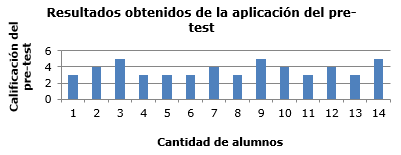 dades
dades
Graph. 1- Results obtained from the applied
pre-test
Source: Own elaboration
Cuban cultural landscapes studied in the training of the Sociocultural Manager and the Standard Plan for its treatment
The following Cuban cultural landscapes are part of the current Study Plan E, in the Social Mediations subject, they hold the recognition of UNESCO and the National Heritage Center of Cuba, they are sites with important heritage values and tourist destinations of international reference. For its characterization, the investigations carried out by Rigol (2014), López (2010); (2017), Melero (2015), the Office of the Conservator of Trinidad, the Office of the Conservator of Matanzas and the Network of Heritage Cities of Cuba.
Canímar River Cultural Landscape (Illustration 1), extends through the municipalities of Matanzas, Cárdenas and Limonar, through the Canímar River basin, from Las Coralinas to its mouth in the Matanzas Bay. It bears natural, archaeological and historical values. The area was an aboriginal settlement since the 16th century, in it pre-Hispanic habitation sites and areas of funeral rituals are preserved. It was a provisioning and water supply area for the Spanish conquerors. Due to its natural conditions, the Canímar River basin exhibits plants and animals of high endemic value. Among the attractions of the place are yacht tours and visits to caves, on whose walls you can see rock art. There are facilities for camping, cafeteria services, restaurants and nightclubs. The landscape registers the El Morrillo castle and the Antonio Guiteras Holmes bridge, a constructive example of contemporary engineering.
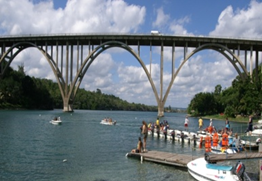
Illustration 1 - Antonio Guiteras Bridge, in the
Canímar River Cultural Landscape.
Source: internet
Cultural landscape of Trinidad and the Valle de los Ingenios (Illustration 2): Located in the south of the province of Sancti Spíritus. The city is one of the first towns founded by the Spanish in Cuba and a living memory of a history of more than four centuries, today a must-stay for thousands of tourists who visit the Cuban archipelago. The Valle de los Ingenios shows the development of the sugar industry in the largest of the Antilles; Located about 13 km from the city of Trinidad, it is a site with an important colonial sugar tradition between the 17th and 19th centuries in Cuba; It is a natural complex where the plain, the mountain and the coast are integrated with its long peninsula of Ancón, carrier of hotel facilities and the port of Casilda; It welcomed a monumental industrial architecture due to its dimensions and wealth of materials, together with unique examples of domestic constructions, known as sugar mill houses, some of which have been preserved to this day. Two UNESCO programs are currently being developed in the landscape: the Sugar Route and the Slave Route.
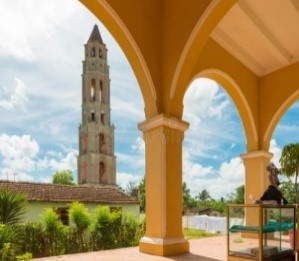
Illustration 2- Bell tower and portal of the Manaca- Iznaga Hacienda, in the Trinidad
Cultural Landscape and the Valle de los Ingenios.
Source: internet
The cultural landscape of El Cobre and the Sites of the Camino de la Imagen de la Virgen del Cobre (Illustration 3), extends from the provinces of Holguín and Santiago de Cuba; It is made up of three large associative sites: La Virgen key, on Pesquero beach, in Nipe bay; the locality of Barajagua and El Cobre, in Santiago de Cuba. The authenticity of the landscape is revealed in the combination of the local panorama, where the picturesqueness of the surrounding relief, characterized by the rugged profile of the mountains and the cultural complex, personified by the urban settlement and the Basilica of the Patron Saint of Cuba, magnify the authenticity of the landscape. of a peculiar urban and economic culture, in relation to its natural environment.
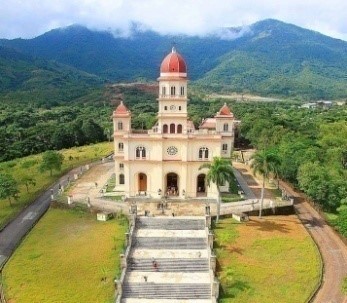
Illustration 3- El Cobre Sanctuary, in the El Cobre cultural landscape and the Sites on the
Path of the Image of the Virgen del Cobre.
Source: internet
Cultural landscape Castle of San Pedro de la Roca (Illustration 4). The Castillo de San Pedro de la Roca or Castillo del Morro, as it is also known, is a military fortress located on the left bank of the bay of Santiago de Cuba; declared by UNESCO, in 1998, as a World Heritage Site. It was built in 1638, with the aim of protecting the city of Santiago de Cuba against attacks by corsairs and pirates; The idea arose from Pedro de la Roca y Borja, who was then governor of the province. The work was carried out by the famous Italian engineer Bautista Antonelli. The fortification is considered an architectural jewel of indisputable aesthetic and historical value in the Caribbean. Currently, in the afternoon, at sunset, the rumble of a cannon is heard, which perpetuates the rebellion and revolutionary pride of the Cuban people.
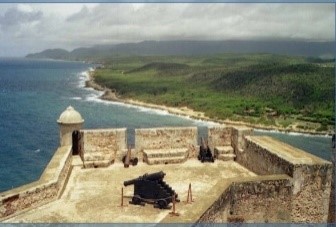
Illustration 4- Morro Castle, in the San Pedro de la Roca Castle Cultural
Landscape.
Source: internet
Archaeological Landscape of the First Coffee Plantations in the Southeast of Cuba (Illustration 5): Located in eastern Cuba, where close to a hundred farms of the aromatic grain make up the so-called Coffee Belt, with notable Franco-Haitian contributions. It extends through areas of Gran Piedra, El Cobre, Dos Palmas and Contramaestre, in Santiago de Cuba and through Yateras, Niceto Pérez, El Salvador and the capital's own municipality, in the province of Guantánamo respectively. The ruins of the coffee plantations from the 19th and early 20th centuries, in the southeast of Cuba, are unique and eloquent testimony of a form of agricultural exploitation in a virgin forest and the traces of these have disappeared in the world. Coffee production in the southeast of Cuba, during the 19th and early 20th centuries, resulted in the creation of a cultural landscape that exemplified a significant stage in the development of this agricultural system. The cultural landscape is a representative international example of the Coffee Route in Cuba and the Caribbean.
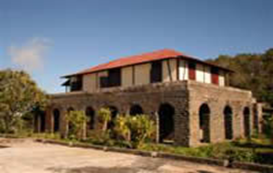
Illustration 5- Casa Hacienda La Isabelica, in the Archaeological Landscape of the First
Coffee Plantations.
Source: internet
Cultural Landscape Valle de Viñales and its Town (Illustration 6): Located in the municipality of Viñales, in the province of Pinar del Río, it was the first cultural landscape recognized by UNESCO in Cuba and Latin America. Its natural beauty, the typical mogotes, the Cueva del Indio with its underground river, the Mural of Prehistory, the Rancho de San Vicente and the fabulous viewpoint of Motel Los Jazmines, are some of the main attractions of the landscape. The valley is an outstanding karst landscape, in which traditional farming methods (mainly tobacco harvesting) have survived unchanged for several centuries. The region also preserves a rich vernacular tradition in its architecture, crafts and music.
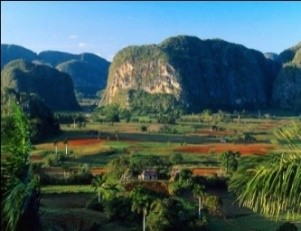
Illustration 6- Cultural landscape Valle de Viñales and its town.
Source: internet
As a result of the study, the following variables and indicators were determined that, organized from didactics (typological approach or Type Plan)) contribute to the knowledge of the cultural landscape and to the initial training of the Sociocultural Manager.
Plan type:
1. Presentation of the cultural landscape: This aspect allows us to offer a brief description of the cultural landscape to be studied; here the objectives, the geographical location, limits, the property or administration regime, the entity responsible for the administration and management of the landscape, the meaning and universal value and the criteria that sustain it in the world and national heritage are presented. During your treatment it is recommended to use maps, plans, photographs and correctly fix the space and time that are taken as references for the study of the landscape. This variable also helps to explain the origin of the place name and the delimitation of the period or historical context selected for the study of the landscape.
2. Natural conditions: It aims to highlight the natural landscape on which the cultural landscape is built. In the treatment of the variable, the presence of characteristic morphological elements within the landscape is analyzed: types and forms of relief, climate, water, soil, vegetation and animals.
3. Culture: It refers to the culture registered in the landscape from sociolinguistic expressions, the culture of socialization (music, musical instruments, dances, theater, clothing, parties, games and the family), the ergonomic culture (architecture , monuments, sculptures, crafts, trades, traditional production techniques, transport and gastronomy), everything linked to magical-religious culture (legends, myths, customs, traditions, popular medicine, beliefs, magic, religion and superstitions).
4. Socioeconomic activities: Covers those aspects related to the population, use of the land and the patrimonial asset, ownership patterns and the economic base that will include agriculture, tourism, local industries, as well as infrastructure, technical networks and of services. All this section will be completed with the use of plans, maps and photographs.
5. Visuals of the landscape: It aims to highlight areas of great natural beauty or high aesthetic value, given by the presence in the landscape of visual characteristics that qualify the area from the aesthetic-visual point of view. The teacher in the treatment of the variable refers to the contrasts of color, texture, shape, scale, lines, to the scenic quality of the observed landscape, the scenic background that highlights the characteristics of the landscape and the aesthetically well-qualified human actions that even the moment is taken as a reference for that landscape.
6. Authenticity: For this variable, the teacher refers to the elements of the landscape that contribute to the identity and originality of the area, as well as the qualities that have given meaning to the landscape.
7. Sustainability of the cultural landscape: In the treatment of its content, the teacher alludes to the policies that are developed: the management, care and sustainability of the landscape, the juridical-legal framework, the adaptation to modern living conditions, the flows visitor receptors, protectionist categories, environmental education, measures against risks, natural and man-made disasters and the conservation of cultural qualities that highlight the values of the site as a cultural landscape.
8. Proposals for socio-cultural actions in the landscape: Actions must be aimed at conservation, administration, legal protection, risk preparation, research, institutional capacity building, training of human resources involved in the cultural landscape, education, diffusion, interpretation, tourism, recreation, visitor management, information, assistance and cooperation, as well as the incorporation of other topics of interest for the site, the career or subjects with interdisciplinary links.
Analysis of the results obtained after the application of the Standard Plan for the study of cultural landscapes
The final results are presented below, obtained from the post-test that was applied in the same group of the race. To verify the results, the same methodological procedures were applied and the same students from the pre-test participated.
Dimension 1: Cognitive-affective
Through participant observation, it was noticed that the students showed willingness and motivation to achieve good results. Between them and the teacher, very favorable environments were created for the success of the activity.
Dimension 2: Skill development
In the application of the instrument (post-test) the 14 students showed the development of communication skills, whose mission was to facilitate the application of the post-test, and organizational skills, with respect to their jobs and the materials to be used.
The final instrument consists of four activities aimed at evaluating general intellectual skills such as: characterize, explain, define concepts, classify and identify, and the specific skill related to the geographical location of landscapes, according to the municipalities and provinces where they are located.
Dimension 3: Education in values
The applied instrument made it possible to evaluate, in the students, through participant observation, values such as honesty, industriousness and responsibility, of great importance in the formation of the Sociocultural Manager.
In a general sense, Graph 2 shows the results achieved, in the instrument applied ( post-test).
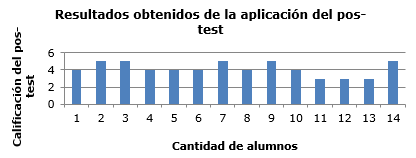
Graph. 2- Results obtained from the applied
post-test
Source: Own elaboration
Next, Graph 3 is presented where the quantitative results obtained in the pre-test can be seen, contrasting with the post-test. The graph shows that there have been changes in the students in the sample, regarding the mastery of the variables and indicators for the study of the cultural landscape.
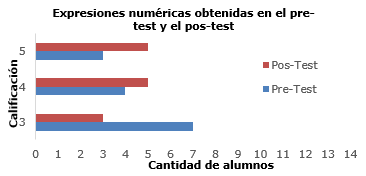
Graph. 3- Integrated numerical results of the pre-test (Blue color) and the post-test (Red color)
Source: Own elaboration
In the cognitive-affective dimension, better results are achieved in the post-test than in the initial cut:
In relation to the dimension aimed at the development of skills, it was possible to verify that:
In the education in values dimension, transformations can be seen in the 14 students:
DISCUSSION
There are investigations dedicated to the cultural landscape (Álvarez, 2018; León, 2018; Cañizares, 2020; Martínez-Osorio, Martínez-Ochoa and Castellanos-Tuirán, 2020); but they are limited from the pedagogical sciences in terms of providing the researcher with orientations and methodological proposals about the fundamental contents of the cultural landscape, understood as an important didactic and training unit, according to the statements of Fernández and Sánchez (2021).
The difficulties in mastering the concept of landscape, from the application of the pre-test to the 4th year students, demonstrated the lack of systematicity with which the term is worked in the different educational subsystems. The notion is introduced in the current program of Geography of Cuba, in 6th grade, the basic text of the subject defines it as: "the area of the terrestrial or maritime surface with certain characteristics and where man carries out certain economic activities" (p. .227). Due to the theoretical-methodological conception of the geography programs, the previous concept is systematized in the transit through Basic Secondary and is deepened in Pre-university.
For its part, the "Pedro Soto Alba" Metallurgical Complex, a mining landscape in which the famous nickel processing plant is located, is studied in Chapter 3 "The physical and economic-geographical regions of Cuba", of the geography program of Cuba, in 6th grade; it is systematized in 9th grade with the study of the Eastern Region and concludes in 11th grade, when the last unit of the program teaches Cuban economic regionalization. However, the approach to the content referred to the formation of the Moa laterites has shortcomings in its theoretical and methodological design, in the study programs; Faced with such a situation, the professor only limits himself to locating the important nickel zone on the map, offers data of socioeconomic interest and highlights its importance for the country's economy. These shortcomings are evident in the unfavorable results achieved by the students, in the application of the pre-test.
The variables and indicators designed and organized through the typological approach contribute to the treatment of the content of the cultural landscapes: Río Canímar, Trinidad and the Valle de Los Ingenios, El Cobre and the Sites of the Camino de la Imagen de la Virgen del Cobre, the Castillo San Pedro de la Roca, the Archaeological Ruins of the First Coffee Plantations in the Southeast of Cuba and the Valley of Viñales and its Town; and to the training of a highly prepared professional, capable of making them suitable socio-cultural management processes, sustainable, responsible and committed to society.
The contents expressed in the variables and indicators make it possible to establish interdisciplinary relationships between the subjects of the current Study Plan E, and find their maximum expression in the subject Social Mediations.
The pre-test carried out also showed that, despite the achievements in the methodological work carried out with the professional model and the work carried out in the groups of disciplines, they are insufficient in their contributions to education in values.
Researchers consider that education in values constitutes the basis of social and personal coexistence. Therefore, the Sociocultural Manager must show responsibility before the heritage, in compliance with its legal regulations, the maintenance and promotion of our cultural practices, customs and traditions, in community and local development, as well as in the drawing up of strategies aimed at sustainable development and the support of cultural identities.
The variables selected for the study of cultural landscapes enable the Sociocultural Manager to achieve an understanding of nature, economy and society relationships, contribute to the development of skills, formation of values, implementation of the strategic objectives of sustainable development and local identity. , in response to the social commission of that professional (Martínez, 2018; Borges, 2020). Therefore, the proposal presented in this article, from the interdisciplinary perspective, contributes to the training of the Sociocultural Manager.
BIBLIOGRAPHIC REFERENCES
Álvarez Larrain, A. (2018). El devenir histórico de los paisajes culturales de un pueblo catamarqueño (Andalhuala, Yocavil, Argentina). Revista colombiana de antropología, 54(1), 219-252.
Borges Machín, A.Y. (2020). Manual teórico-metodológico de orientación al docente para la dirección del proceso de formación de la habilidad profesional integradora, Gestión sociocultural. Feijóo.
Cambón Freire, E. del C. (2009). Paisajes culturales como patrimonio: criterios para su identificación y evaluación. Revista Científica De Arquitectura Y Urbanismo, 30(1), 1017. https://rau.cujae.edu.cu/index.php/revistaau/article/view/79
Cañizares Ruiz, M. del C. (2014). Paisajes culturales, ordenación del territorio y reflexiones desde la geografía en España. Polígonos, Revista de Geografía, (26), 147-180.
Cañizares Ruiz, M. del C. (2020). Procesos y retos en torno al patrimonio y a los paisajes culturales: una reflexión teórica desde la geografía española. Revista de Geografía Norte Grande, 76, 189-212.
Espinosa Ocallaghan, M. (2007). Paisajes culturales en el oriente cubano. La gran piedra y su entorno. Ciencia en su PC, (4), 79-90.
Fernández Díaz, D.M. y Sánchez Giner, M.V. (2021). El paisaje cultural como recurso educativo indispensable para reflexionar acerca de la relación Hombre-Naturaleza. Revista Nuevas Tendencias en Antropología, (11), 21-44.
León B., J.M. (2018). Paisaje cultural y una nueva forma de entender el Patrimonio en Ecuador. Revista Interamericana de Ambiente y Turismo, 14(2), 161-169.
López Segrera, Y. (2010). La Conservación del patrimonio cafetalero en el sudeste de Cuba: El Plan de Manejo Integral de un Paisaje Arqueológico. Apuntes 22(2), 172-183.
López Segrera, Y. (2017). Del Batey cafetalero al Paisaje Cultural: trascendencia de la autenticidad. Batey. Revista Cubana de Antropología Sociocultural, 9(9), 69-76.
Martínez Casanova, M. (2018). Gestión Sociocultural. Félix Varela: La Habana
Martínez-Osorio, P.A., Martínez-Ochoa, F.H. y Castellanos-Tuirán, A. (2020). Paisaje e imaginarios urbanos: dinámicas en la construcción de identidad y sentido de lugar en Sincelejo, Colombia. Estoa, 9(18), 37-44. DOI: 10.18537/est.v009.n018.a03
Melero Lazo, R.N. (2015). Paisaje Culturales. En Monumentos Nacionales de la República de Cuba, Collage Ediciones, Consejo Nacional de Patrimonio. La Habana.
Rigol Savio, I. (2014). Programa de Desarrollo del Caribe. Gestión de Paisajes culturales. Módulo 4. Oficina Regional de Cultura para América Latina y el Caribe de la UNESCO. La Habana.
Conflict of interests:
The authors declare not to have any interest conflicts.
Contribution of the authors:
The authors participated in the design and writing of the work, and analysis of the documents.
![]()
This work is licensed under a Creative Commons Attribution-NonCommercial 4.0
International License
Copyright (c) Cebey Sánchez, JA, Villalón Legrá , G., & Mederos Jiménez, Y.